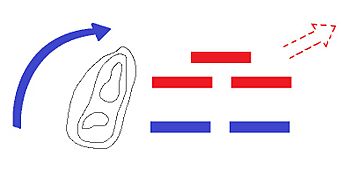Turning movement facts for kids

A turning movement is a smart military plan. It's also called a wide envelopment. The idea is to go around the enemy's main forces to attack a very important spot behind them. Think of it like a sports team trying to get around the other team's defense to score from an unexpected direction.
In this tactic, an army splits into two parts. One part stays in front of the enemy, keeping them busy. The other part moves far around the enemy's side or back. This second group tries to avoid being seen until they are deep behind the enemy lines. Unlike other moves, these two parts of the army are often too far apart to help each other right away. When the enemy suddenly finds soldiers behind them, they have to quickly change their plans. They might have to leave their strong position or turn around to fight the new threat. This forces them to "turn" away from their original defense.
Contents
Famous Examples of Turning Movements
This clever tactic has been used throughout history by many famous leaders. It's a great way to surprise an opponent.
Julius Caesar's Surprise Attack
One of the earliest known examples of a turning movement was used by Julius Caesar in 48 BC. He was a brilliant Roman general. He used this move to outsmart his enemies.
Napoleon's Favorite Trick
Napoleon I of France loved using the turning movement. He called it the "Strategy of Indirect Approach." He would send one part of his army to grab the enemy's attention. Meanwhile, his main army would make a huge circle, often hidden by hills or forests. They would then appear behind the enemy.
Napoleon used this tactic very well in 1805 during his Ulm Campaign. He also had great success with it at the Battle of Jena–Auerstedt in 1806. And he used it again at the Battle of Friedland in 1807. These victories showed how powerful a turning movement could be.
The "Left Hook" in the Gulf War
A more recent example happened during Operation Desert Storm in the Gulf War. This was in 1991. American and French troops used a famous "left hook" maneuver.
American paratroopers from the 82nd Airborne Division and French soldiers from the 6th Light Armoured Brigade moved around the sides of the enemy. At the same time, the American 101st Airborne Division made the biggest helicopter attack in history. They landed behind Saddam Hussein's Republican Guard. This move cut off the enemy's escape route. It was a perfect example of a turning movement.
Related Military Tactics
- Envelopment
- Pincer movement (also known as a double-envelopment)
- Flanking maneuver
- Rearguard
- Attrition warfare
- Feigned retreat
- Preemptive war
- Oblique order
- Shock tactics

